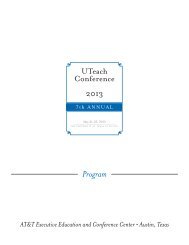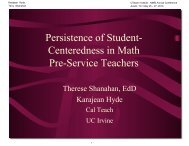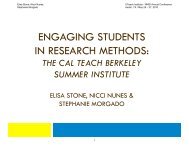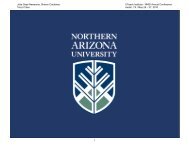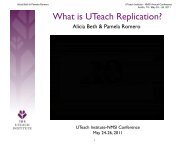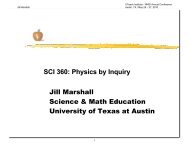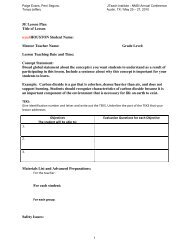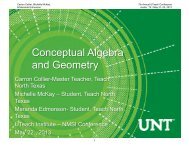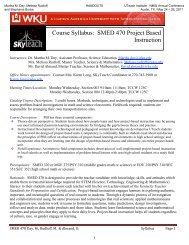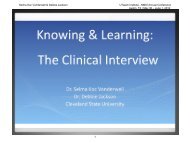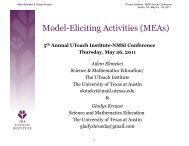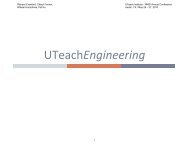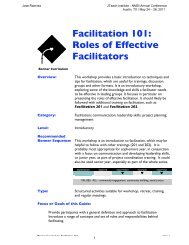Daniels_FFRM_Course Outline - The UTeach Institute
Daniels_FFRM_Course Outline - The UTeach Institute
Daniels_FFRM_Course Outline - The UTeach Institute
Create successful ePaper yourself
Turn your PDF publications into a flip-book with our unique Google optimized e-Paper software.
Mark <strong>Daniels</strong><br />
<strong>UTeach</strong> <strong>Institute</strong> - NMSI Annual Conference<br />
Austin, TX / May 25 – 27, 2010<br />
Foundations, Functions, and Regression Models<br />
<strong>Course</strong> <strong>Outline</strong><br />
DAY<br />
TOPIC OR ACTIVITY<br />
1/19 1 st Day Handouts. Prob solving - Conundrum. Connections 1.<br />
UNIT 1 Functions and Patterns<br />
1/21 Definition of Function. Function Sorting Activity.<br />
Writing - Def. Of Function.<br />
1/26 3 Definitions of Function. Parabola Roots Exploration.<br />
1/28 A qualitative look at ‘rate of change’ of f . Finding Roots Prob. Continued.<br />
2/2 Exponential Growth and decay<br />
2/4 Conic Sections. Homework 1<br />
2/9 Conic Sections continued<br />
2/11 Spring Mass Lab Homework 1 Due<br />
2/16 Sequences. Triangular Differences Activity<br />
2/18 Triangular Differences continued. Homework 2<br />
2/23 Functions as Sequences (i.e. Function Patterns)<br />
2/25 Functions Patterns Exploration Homework 2 Due<br />
UNIT 2 Modeling Using Regression and Matrices<br />
3/2 Modeling Functions from data: Thunder Storms, Charles Law, and Linear<br />
Regression<br />
3/4 TEST 1<br />
3/9 Modeling Functions from data. More regression. Residuals.<br />
Midterm Assignment<br />
3/11 Terminal Velocity Lab Homework 3<br />
3/23 Modeling Functions from Data: Data with Matrices<br />
3/25 Modeling Functions from Data: Standard Forms Homework 3 Due<br />
3/30 Roller Coaster Exploration<br />
UNIT 3 Exploring Relations in Other Systems<br />
4/1 Parametric models Midterm Assignment Due<br />
4/6 TEST 2<br />
4/8 Parametric Exploration Problems<br />
4/13 Vector Lab<br />
4/15 <strong>The</strong> Golf Shot<br />
4/20 Polar Coordinate System Homework 4<br />
4/22 Geometry of Complex Numbers<br />
4/27 Geometry of Complex Numbers continued Homework 4 Due<br />
4/29 Polar Complex - Euler Numb<br />
5/4 TEST 3<br />
5/6 Polar Complex - Euler Numb<br />
1
Mark <strong>Daniels</strong><br />
<strong>UTeach</strong> <strong>Institute</strong> - NMSI Annual Conference<br />
Austin, TX / May 25 – 27, 2010<br />
M315C<br />
P(x) Problem<br />
2
Mark <strong>Daniels</strong><br />
<strong>UTeach</strong> <strong>Institute</strong> - NMSI Annual Conference<br />
Austin, TX / May 25 – 27, 2010<br />
M315C<br />
Graphing “Cartesian Functions” in Polar Coordinates: Part I<br />
Introduction. Doppler radar used on television to report weather conditions;<br />
radar screens used by air traffic controllers to monitor aircraft traffic at an airport; flight<br />
plans filed by private aircraft to indicate paths taken as they move from one point to<br />
another; sonar positioning techniques employed in submarines; distances and compass<br />
bearings for directions used by campers in wilderness areas – these are but a few<br />
examples of the occurrence of vectors and polar coordinates in everyday life.<br />
In this exploration we will limit the domain of our functions to the set of nonnegative<br />
real numbers.<br />
1. Linear expressions.<br />
a) We begin with a constant function y = c, where c >0.<br />
Figure 1a<br />
In this example, the vectors in Cartesian coordinates easily translate to vectors of fixed<br />
length bound at the origin with the tip of the vector lying on a circle of radius c.<br />
3
Mark <strong>Daniels</strong><br />
<strong>UTeach</strong> <strong>Institute</strong> - NMSI Annual Conference<br />
Austin, TX / May 25 – 27, 2010<br />
Figure 1b<br />
b) One should have little difficulty in graphing y = x, and can use this to interpret<br />
what should take place with the graph of r = 0 for 0 ≥ 0. Use the ‘vector approach’ of<br />
the previous example as a guide to do this.<br />
4
Mark <strong>Daniels</strong><br />
<strong>UTeach</strong> <strong>Institute</strong> - NMSI Annual Conference<br />
Austin, TX / May 25 – 27, 2010<br />
Further explorations can now be carried out with general linear<br />
expressions such as y = ax + b and the corresponding polar functions r = a0 + b.<br />
2. Quadratic Expressions. We next consider polar quadratic functions of<br />
the form: r = (0 - a)( 0 - b), where 0 < a < b; r = (0 - a) 2 , where a > 0; and<br />
r = 0 2 + a0 + b, where r(0 ) ≠ 0 for all 0.<br />
a) We will work with y = x 2 – 3x + 2 = (x – 1) (x – 2). <strong>The</strong> vertex of the<br />
parabolic graph is at (3/2, -1/4) with axis of symmetry at x = 3/2. For the polar<br />
graph r = (0 - 1)( 0 - 2), consider three rays corresponding to the values of 0 = 1<br />
rad, 0 = 3/2 rad and 0 = 2 rad. Graph both functions on the provided grids (you<br />
may have to adjust your scale on each axis) and, once again, use the ‘vector<br />
approach’ to explore the connection between the graphs in these two systems.<br />
5
Mark <strong>Daniels</strong><br />
<strong>UTeach</strong> <strong>Institute</strong> - NMSI Annual Conference<br />
Austin, TX / May 25 – 27, 2010<br />
b) Our last example deals with a quadratic have only one positive real<br />
root, y = x 2 – 4x + 4 = (x – 2) 2 , with the corresponding polar curve r = 0 2 – 40 + 4<br />
= (0 - 2) 2 . In this example there is one important ray to consider, the ray 0 = 2.<br />
Perform the same ‘vector approach’ to explore the connection between these graphs in<br />
the two systems.<br />
6
Mark <strong>Daniels</strong><br />
<strong>UTeach</strong> <strong>Institute</strong> - NMSI Annual Conference<br />
Austin, TX / May 25 – 27, 2010<br />
c) Next consider a quadratic such as y = x 2 - 4x + 8 which has no real roots and is<br />
positive for all values of x. Perform the same systems exploration.<br />
7
Mark <strong>Daniels</strong><br />
<strong>UTeach</strong> <strong>Institute</strong> - NMSI Annual Conference<br />
Austin, TX / May 25 – 27, 2010<br />
8
Mark <strong>Daniels</strong><br />
M315C<br />
<strong>UTeach</strong> <strong>Institute</strong> - NMSI Annual Conference<br />
Austin, TX / May 25 – 27, 2010<br />
Graphing “Cartesian Functions” in Polar Coordinates: Part II<br />
For Further Consideration<br />
As a challenge, use what you learned previously about Rectangular-Polar<br />
graphing connections and the Cartesian graph provided in Figure 1 to create a<br />
‘polar version’ of the graph for .<br />
Figure 1<br />
9
Mark <strong>Daniels</strong><br />
<strong>UTeach</strong> <strong>Institute</strong> - NMSI Annual Conference<br />
Austin, TX / May 25 – 27, 2010<br />
Math 315C<br />
<strong>The</strong> Roller Coaster Project<br />
An established company, the Acme Roller Coaster Company, has asked your group to help<br />
design a roller coaster track.<br />
<strong>The</strong> Acme Company wants to build a roller coaster subject to a set of constraints. You are<br />
told that the company has several engineers who could design a blueprint and build the<br />
track if only they knew the functions whose graphs would define the desired curve of the<br />
track. According to a company spokesperson, her people can easily "fit" a curve to a set of<br />
points; however, the resulting curve does not necessarily satisfy constraints involving<br />
slopes, concavity, extrema values, smoothness, updateability, etc. Furthermore the<br />
companies engineers must first build a scaled down test model, and thus they need the<br />
function description for the scale model. Hence your task is to define a piecewise function<br />
over the interval [0,15] whose graph satisfies the following constraints for the roller<br />
coaster track (each unit represents 10 meters).<br />
1. <strong>The</strong> entrance onto the track is at the point (0,10) and the exit is at (15,0). <strong>The</strong>re<br />
are just two local extrema, a minimum at (4,2) and a maximum at (8,8). (You<br />
do not have to consider designing the stairs leading to the entrance.)<br />
2. <strong>The</strong> slope of the curve at the entrance and exit points must be zero in order to<br />
facilitate getting on and off the roller coaster car.<br />
3. IMPORTANT: <strong>The</strong> curve must be "smooth" meaning that the piecewise<br />
function must be differentiable over its entire domain.<br />
4. For continued customer interest, maintenance, and future customization<br />
YOU MUST build the roller coaster track out of pieces. Based on the<br />
given constraints, you must also decide how many functions that you<br />
will ‘sew together’ to build the track.<br />
<strong>The</strong> Acme Company is skeptical of work that has not been refined, stating that whenever,<br />
safety, cost, or time is involved they will not accept the plans of a single person. <strong>The</strong>refore,<br />
you are to work in a group of three or four people.<br />
10
Mark <strong>Daniels</strong><br />
<strong>UTeach</strong> <strong>Institute</strong> - NMSI Annual Conference<br />
Austin, TX / May 25 – 27, 2010<br />
An exploration based approach to<br />
Foundations, Functions,<br />
And<br />
Regression Models<br />
Efraim P. Armendariz<br />
&<br />
Mark L. <strong>Daniels</strong><br />
© 2010<br />
PARTIAL DRAFT: V2<br />
11
Mark <strong>Daniels</strong><br />
<strong>UTeach</strong> <strong>Institute</strong> - NMSI Annual Conference<br />
Austin, TX / May 25 – 27, 2010<br />
12
Mark <strong>Daniels</strong><br />
<strong>UTeach</strong> <strong>Institute</strong> - NMSI Annual Conference<br />
Austin, TX / May 25 – 27, 2010<br />
Contents<br />
PREFACE<br />
An exploration based approach to Foundations, Functions And<br />
Regression Models<br />
About this text<br />
Suggestions for using this text<br />
INTRODUCTION<br />
An exploration based approach to Foundations, Functions And<br />
Regression Models<br />
UNIT ONE<br />
Functions and Patterns<br />
Day 1 - Getting Started<br />
Day 2 - What is a Function<br />
Day3 - Functions and Types of Functions<br />
<strong>The</strong> Ubiquitous Quadratic Function<br />
Day 4 - A Qualitative Look at Rates<br />
Day 5 - A Further Investigation of Rate of Change<br />
Day 6 - Conic Sections<br />
Day 7 - Spring-Mass motion Lab<br />
Day 8 - Sequences and Triangular Differences<br />
Day 9 - Functions Defined by Patterns<br />
Day 10 - Function Pattern Application<br />
UNIT TWO<br />
REGRESSION AND MODELING<br />
Day 11 - Using Statistical Regression to Fit a Function to Bivariate Data<br />
Day 12 - Residual Plots and an Application<br />
13
Mark <strong>Daniels</strong><br />
<strong>UTeach</strong> <strong>Institute</strong> - NMSI Annual Conference<br />
Austin, TX / May 25 – 27, 2010<br />
Day 13 - Terminal Speed Lab - Lab 2<br />
More to come…..<br />
14
Mark <strong>Daniels</strong><br />
<strong>UTeach</strong> <strong>Institute</strong> - NMSI Annual Conference<br />
Austin, TX / May 25 – 27, 2010<br />
PREFACE<br />
An Exploration Based Approach to Foundations,<br />
Functions, And Regression Models<br />
About This Text<br />
<strong>The</strong> presentation of topics in this text is done in a “discovery-based” format so as to<br />
invite the learner/reader to actively participate in the Explorations that develop the<br />
material in a logical manner.<br />
This textbook is intended to be used primarily for a one-semester lower-division<br />
mathematics course. <strong>The</strong> course assumes that students have a working knowledge of the<br />
basic concepts of calculus associated with differentiation and integration, but this is not a<br />
rigid prerequisite. Due to the collaborative nature of the delivery of the course, we have<br />
had students succeed in the course who have not had a Calculus background. <strong>The</strong> topics<br />
covered in this text serve to synthesize important topics from secondary mathematics<br />
curriculum and to connect these topics to university level mathematics. We believe that<br />
the material and mathematical connections made in this text are worthwhile and<br />
extremely well suited for a discovery-based mathematics course for preservice secondary<br />
teachers. <strong>The</strong> course topics were born out of notes used for an introductory mathematics<br />
course that is taught to lower-division mathematics majors in the <strong>UTeach</strong> Program in the<br />
College of Natural Sciences at the University of Texas. <strong>UTeach</strong> mathematics majors, in<br />
addition to earning an undergraduate degree in mathematics, are seeking state teaching<br />
certification in middle school or high school mathematics.<br />
Suggestions for Using This Text<br />
Instructors of a course using this text are encouraged to present the material of the book<br />
in an inquiry-based method. That is, allow students to work through the Explorations of<br />
the text collaboratively and devote considerable class time to student presentation of<br />
results. <strong>The</strong> instructor is further encouraged to take on the role of facilitator in the course<br />
in that one of the goals of the course would be to bring students to the point where<br />
students would not simply present results but also challenge and correct each other<br />
concerning the formal logic, mathematical language, and methods employed in their<br />
presentations. This is a book and a course about getting students to think deeply and<br />
logically about fundamental ideas in mathematics.<br />
Further, instructors are encouraged to add any relevant topics, exercises, and explorations<br />
to those presented in the text that are felt necessary based on student make-up and<br />
individual goals for the course. <strong>The</strong> authors welcome any suggestions along those lines.<br />
Please feel free to use the material of the text as a springboard for exploration of<br />
tangential topics and connections based upon student interest, deficiencies, and<br />
discussion.<br />
15
Mark <strong>Daniels</strong><br />
<strong>UTeach</strong> <strong>Institute</strong> - NMSI Annual Conference<br />
Austin, TX / May 25 – 27, 2010<br />
Lastly, to the student, we encourage students to view the topics and Explorations of the<br />
text as vehicles to be used toward thinking deeply about concepts and connections<br />
between concepts that you may have seen before but not in the same depth or context.<br />
16
Mark <strong>Daniels</strong><br />
<strong>UTeach</strong> <strong>Institute</strong> - NMSI Annual Conference<br />
Austin, TX / May 25 – 27, 2010<br />
INTRODUCTION<br />
An Exploration Based Approach to Foundations,<br />
Functions, And Regression Models<br />
<strong>The</strong> layout of this text is presented in sections labeled by “day” of instruction. It is<br />
assumed that these days correspond to class periods of approximately one and one-half<br />
hours in duration. Even so, it may be the case that you don’t use all of the Explorations<br />
within, or that you don’t finish the Explorations of each day, or that you are working with<br />
a shorter class period in which some Explorations will continue over multiple days. <strong>The</strong><br />
“day” sections are numbered in order and do not include such things as time allotted for<br />
class tests.<br />
<strong>The</strong> key to experiencing this course is to approach the associated teaching and learning<br />
with a flexible mindset. Let the Explorations take you in many directions based upon the<br />
presentation and discussion of the material under investigation. Consider and be open to<br />
the fact that there are often multiple ways to approach or obtain the desired result for a<br />
given Exploration. Much of the learning in this course will come from listening to others’<br />
justifications and explanations of how a result was obtained.<br />
Let us begin!<br />
17
Mark <strong>Daniels</strong><br />
<strong>UTeach</strong> <strong>Institute</strong> - NMSI Annual Conference<br />
Austin, TX / May 25 – 27, 2010<br />
UNIT ONE<br />
FUNCTIONS AND PATTERNS<br />
Day 1: Getting Started<br />
<strong>The</strong> three Explorations of this section are meant to “get you started” on the right track<br />
regarding the expectations of this text. This text is meant to accompany a mathematics<br />
course that, among other things, is about “thinking”. By this we mean it is our intention<br />
that the activities presented within will entice you to think deeply about some of the<br />
mathematics you’ve encountered previously, about new ideas presented, and about the<br />
connections between the two. With this in mind, let’s get started.<br />
Exploration 1.1: A Common Cube Conundrum<br />
Suppose one desired to move along the surface of the cube from the top far corner<br />
(point A) to the near bottom corner (point B). Would the dark line path marked in the<br />
picture be the shortest route from point A to point B? If you agree, justify your answer.<br />
If you do not agree, describe the shortest path and justify your answer. Is the shortest<br />
path solution that you have chosen unique?<br />
18
Mark <strong>Daniels</strong><br />
<strong>UTeach</strong> <strong>Institute</strong> - NMSI Annual Conference<br />
Austin, TX / May 25 – 27, 2010<br />
Exploration 1.2: <strong>The</strong> Efficient Waterline<br />
<strong>The</strong> city wishes to connect two houses to an existing water supply line using a single<br />
pump at the supply line and a minimal amount of pipe extended to each house. <strong>The</strong><br />
houses are located at different distances from the street (as pictured). Where should the<br />
pump connection be located? Of course, you must justify your answer.<br />
As mentioned previously, it is important that you also make connections between<br />
mathematics concepts you are asked to remember and that you newly learn in this course.<br />
<strong>The</strong> next Exploration is a good example of making connections between topics and<br />
concepts in mathematics.<br />
Exploration 1.3: Making Connections<br />
Given the three topics listed below, devise a visual, verbal, and algebraic way of<br />
connecting the concepts:<br />
1. <strong>The</strong> distance formula<br />
2. <strong>The</strong> standard equation of a circle (not centered at the origin)<br />
3. <strong>The</strong> Pythagorean <strong>The</strong>orem<br />
Can you think of further related topics that can be extended from these three?<br />
19
Mark <strong>Daniels</strong><br />
<strong>UTeach</strong> <strong>Institute</strong> - NMSI Annual Conference<br />
Austin, TX / May 25 – 27, 2010<br />
Day 2: What is a Function?<br />
In this section, we will take a deeper look at the concept of function in terms of a<br />
function’s definition, type, and general properties. You have encountered and worked<br />
with functions in your mathematical experiences so far, but have you really thought much<br />
about what constitutes a function?<br />
Exploration 2.1: Function?<br />
Work in groups to answer the question, “What is your definition of a function?” Each<br />
group should agree upon and present one definition.<br />
Each group should also display their agreed upon definition for the class and all<br />
definitions should be recorded by each student. At this point, however, a formal<br />
definition of function should not yet be agreed upon and formulated.<br />
Exploration 2.2: Function an Identification Activity 1<br />
FUNCTION - IDENTIFY?<br />
Decide, in groups, which of the relations listed below are examples of functions; justify<br />
your answers.<br />
FUNCTION?<br />
JUSTIFICATION<br />
1<br />
y = x 2<br />
2<br />
x y<br />
2 4<br />
-6 -12<br />
13 26<br />
-57 -114<br />
20
Mark <strong>Daniels</strong><br />
<strong>UTeach</strong> <strong>Institute</strong> - NMSI Annual Conference<br />
Austin, TX / May 25 – 27, 2010<br />
-57 -114<br />
3<br />
(3, 6)<br />
(3, 2)<br />
(2, 1)<br />
4<br />
y 4 = x 2<br />
Also identify: What does the graph of this<br />
relation look like?<br />
5<br />
6<br />
7<br />
21
Mark <strong>Daniels</strong><br />
<strong>UTeach</strong> <strong>Institute</strong> - NMSI Annual Conference<br />
Austin, TX / May 25 – 27, 2010<br />
Exploration 2.4: “Mapping” a Map<br />
Use any the information supplied in the map below or any subset of the information<br />
provided to create a function. Be sure to explain your reasoning behind the creation of<br />
your function.<br />
22
Mark <strong>Daniels</strong><br />
<strong>UTeach</strong> <strong>Institute</strong> - NMSI Annual Conference<br />
Austin, TX / May 25 – 27, 2010<br />
Exploration 2.4: Function Identification Activity 2<br />
As you discuss these problems, consider the meaning of the symbols in the set-builder<br />
notation. <strong>The</strong>se symbols should be discussed in class as part of the next section.<br />
1. Let A = (a, b, c}, B = {4, 5, 6}, and f = {(a, 6),<br />
(b, 4), (c, 6)}. Is f a function from A to B?<br />
2. Let A = {1, 2, 3}, B = {c, d, e}, and g = {(1, d, (2, c), (1, e)}.<br />
Is g a function from A to B?<br />
3. Let M be the set of all museums, N the set of all<br />
countries, and .<br />
Is L a function from M to N?<br />
4. Let D be the set of all dogs, and let<br />
Is C a function from D to D?<br />
.<br />
TAKE HOME EXERCISE: Reflect on your informal work in trying to describe what a<br />
function is and consider the various group definitions of function presented. Now revise<br />
the definition you originally created for describing a function in order to develop a more<br />
refined definition. Explain your reasons for refining (or not refining) your function<br />
definition.<br />
23
Mark <strong>Daniels</strong><br />
<strong>UTeach</strong> <strong>Institute</strong> - NMSI Annual Conference<br />
Austin, TX / May 25 – 27, 2010<br />
Day 3: Functions and Types of Functions<br />
We will now attempt to formalize our definition of function by providing three textbook<br />
definitions of the concept of function. Note the use of the symbols in each definition. As<br />
you read over the three provided definitions of a function, you are asked to consider the<br />
commonality and differences between these definitions and the one which you have<br />
previously written. Three examples of how a function might be defined are:<br />
Given two sets A and B, the set consists of all ordered pairs (a, b) where a A,<br />
b B. A subset of is called a relation. Thus:<br />
1. A function from A to B is a pairing of elements in A with elements in B in such a way<br />
that each element in A is paired with exactly one element in B.<br />
2. A function f from A to B is a rule or relation between A and B that assigns each<br />
element a A to a unique element b B.<br />
3. A function f from A to B is a subset of the Cartesian product<br />
= {(a, b) | a A, b B} such that b is unique for each a A.<br />
•<br />
•<br />
•<br />
•<br />
•<br />
•<br />
•<br />
f<br />
•<br />
•<br />
•<br />
•<br />
•<br />
•<br />
•<br />
•<br />
•<br />
A<br />
B<br />
24
Mark <strong>Daniels</strong><br />
<strong>UTeach</strong> <strong>Institute</strong> - NMSI Annual Conference<br />
Austin, TX / May 25 – 27, 2010<br />
4. A function between A and B is a nonempty relation<br />
. <strong>The</strong> domain of f is<br />
the set of all first elements of members of f and the range of f is the set of<br />
all second elements of members of f. Symbollically:<br />
<strong>The</strong> set B is referred to as the codomain of f . If it happens that the domain of f is<br />
equal to all of A, then we say f is a function from A into B and we write .<br />
EXERCISE: Consider, why it is or is it not important to have a precise definition of the<br />
term function.<br />
Historical Notes<br />
1. Although the notion of a function dates back to the seventeenth century,<br />
a relation based definition as we use today, was not formulated until the<br />
beginning of the twentieth century. <strong>The</strong> concept of mathematical relations<br />
first appears in Rene Descarte’s 1637 text, Geometry and the term<br />
“function” was introduced about fifty years later by Gottfried Wilhelm<br />
Leibniz. It was Leonhard Euler, in the eighteenth century, who first used<br />
today’s notation y = f(x). Finally, it was Hardy who defined, in 1908, a<br />
function as a relation between two variables x and y such that “to some<br />
values of x at any rate correspond values of y.”<br />
2. French author Nicolas Bourbáki, is not a single author but a group of<br />
authors, came together in the late 1950’s in an effort to standardize the<br />
language of modern mathematics. That language is used in the definitions<br />
that follow. Among the group was mathematician John Tate, who later<br />
became a faculty member at the University of Texas at Austin..<br />
25
Mark <strong>Daniels</strong><br />
<strong>UTeach</strong> <strong>Institute</strong> - NMSI Annual Conference<br />
Austin, TX / May 25 – 27, 2010<br />
In addition to knowing whether one is working with a function or not, it is often useful to<br />
know the type of function under investigation based upon the mapping properties of the<br />
function.<br />
26



